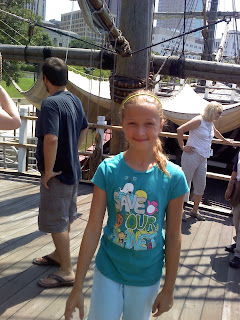In July 2011, before visiting the Museum of Science and Industry in Columbus OH called COSI, my family and I decided to visit the Santa Maria Museum on the other side of the Scioto River. For about $15 the whole family could take a short tour of the full-scale replica of the Santa Maria that Christopher Columbus sailed on August 3rd, 1492 (along with the Pinta and Nina) from Palos de la Frontera, Spain with 39 men in 1492. This, of course, became the first voyage to have a lasting impact on the New World.
The replica ship was built in the 1990’s as part the commemoration of the 500th anniversary of the Columbus expeditions. It seemed like a good opportunity to get a hands-on idea of what it was like to live on a 15th-century sailing vessel.
Founded in 1812 the city of Columbus, is named after Christopher Columbus and was designed to be the state capital to replace Chillicothe in that role for it's more central state location and it's proximity to the confluence of the Scioto and Olentangy rivers. Prior to 1812, Columbus OH did not even exist as a settlement, it was just forest.
 |
| that's Chris back there |
This ship, like the original, was only about 75 ft x 26 ft which seems even smaller when you are standing on it. During our 45 minute tour, as our guide described the living conditions of the men with a few livestock aboard along with the rats, filthy drinking water, bathroom considerations, etc, you could get a real sense of how cramped and filthy this ship must have been for those 2 months although history books seem to up the ante on the trip. While it was a long hard trip, they did enjoy relatively good weather most of the time per Columbus’ journal. There was a long stopover in the Canary Islands for storm damage repairs which made the actual voyage only 5 weeks. Still, it's hard to imagine 40 men living here even under the best conditions.
 |
| 15th-century toilet paper |
It was a good tour of the ship and I was pretty happy to NOT hear a single word about the myth that people then thought the world was flat. The flat earth myth so often reported by history books was invented by historian Washington Irving in 1828 who decided to add some flavor to this story to make it more exciting and romantic and have a story of sailors risking sailing over the edge of the Earth. Pure make-believe. This story appears nowhere before his time. Mariners and educated people knew the Earth was a sphere back then.
 |
| Oh Columbus! |
I do feel compelled to comment on a couple of items mentioned on the tour that I feel are inaccurate.
She remarked that the "natives" Columbus encountered in what is now San Salvador Island (she didn't refer to them as Arawaks or Indians at all) "were naked and had nothing and were eager to trade". This may be true but not for the reason she implied. They were certainly impressed by the items Columbus had that they had never seen before but the Arawak were self-sufficient for thousands of years and in good health even by Columbus' observations. A Spanish writer wrote in 1518 that "these islands were full of people lacking nothing they needed" but after European contact "they were laid waste". That's a bit different than the suggestion these were stupid poor savage natives which is what was implied. If she was going to gloss over contact with the Arawak and not even mention them by name, she should just leave this simplistic Disney story out of the script completely or at least call them by their name. The book 1491 is a good read if you want to know more about pre-Columbian Indian culture.
 |
| no ladies allowed in 1492 |
Overall it really was a great tour despite some slight historical inaccuracies. I would recommend it to anyone who is in the area who would like to see a great reproduction of 15th-century sailing vessel. That's not something very common anywhere in Ohio! One recommendation...just maybe go when it's not 90+ degrees.
UPDATE 2017: I that the ship is now in storage due to various factors but mainly because of extensively needed repairs. There are no current plans to re-open.
UPDATE 2017: I that the ship is now in storage due to various factors but mainly because of extensively needed repairs. There are no current plans to re-open.




